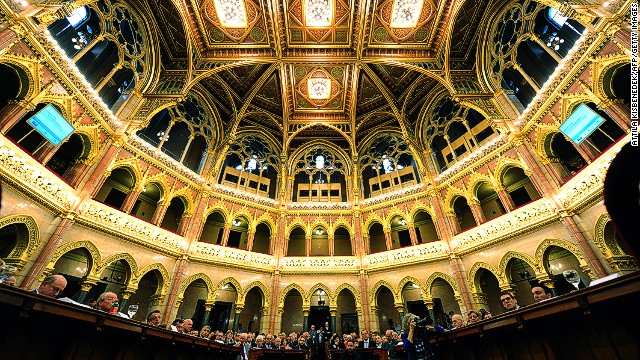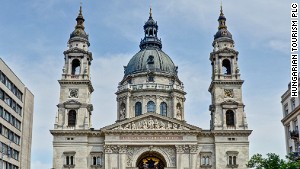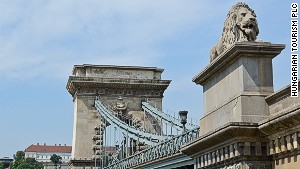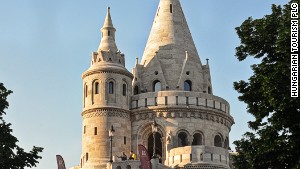Unlike most other cities in the region, however, Budapest doesn't need the comparison.
The grand old dame on the Danube is one of Europe's finest capitals by any measure.
The eight landmark
buildings below give you a feel for both Pest and Buda -- originally
separate cities, divided by the river, but united about 150 years ago to
form the modern metropolis.
Visit these sights in the
order presented here and they form a walking tour of sorts (see map to
the left), albeit with the option of jumping on public transport or
taking the odd taxi.
Taxis are easy to spot in
their bright new yellow livery. Take the subway and you'll be traveling
on the world's second oldest underground railway and, on Line 1, a
World Heritage Site.
Parliament
Taking 17 years to build and completed in 1902, this neo-Gothic structure was partly inspired by the UK's Palace of Westminster.
British
politician-turned-broadcaster Michael Portillo memorably described it as
"one of the most beautiful legislatures in the world, a cathedral of
democracy."
Kossuth Lajos Square in
front of the building is being renovated, so the best views are
currently from the river (Parliament is right on the Pest embankment) or
the opposite Buda banks.
St. Stephen's Basilica
Taking even longer -- 50 years -- than Parliament to complete, the biggest church in Budapest finally opened in 1906.
During construction the building's dome collapsed and two of the three lead architects died.
St. Stephen's Basilica contains the mummified hand -- called the "Holy Right" -- of Hungary's founding king-saint, Stephen (István).
The dome is the same
height as Parliament -- current legislation forbids anything higher, so
Budapest isn't going to get its own version of London's Shard any time
soon.
The church is free to
enter, though it costs 500 forints ($2.30) to climb up to the
observation deck surrounding the 96-meter high dome (closed from
November to the end of March).
St. Stephen's Basillica, Szent István tér 1, 1051 Budapest; more on VisitBudapest.travel
Hungarian State Opera House
A lot of building rivalry has gone on in Budapest.
The Austro-Hungarian
Emperor Franz Joseph approved (and partially paid for) the construction
of an opera house in the city on the condition it was no bigger than the
one in Vienna.
Smaller it may have been
but it was far more opulent -- the emperor's reported reaction on
seeing it at the grand opening in 1884 was to mutter, "These
Hungarians!"
You can visit the ornate building on a tour but, even better, see it while watching an opera or ballet performance.
Another World Heritage
Site, the opera house is located on Andrássy út, Budapest's grand
boulevard full of high-end shops and other magnificent buildings.
Hungarian State Opera House, Andrássy út 22, 1061 Budapest; +36 1 814-7100; more information on performance tickets or guided tours
More: 11 things to know before visiting Hungary
Dohány utca Synagogue
Consecrated in 1859, the
Moorish revival-style building is a center of Neolog Judaism, a
moderate reformed branch of the religion.
The complex also
includes a museum and, in the rear courtyard, a memorial to Jewish
Holocaust victims in the form of a weeping willow with the names of the
dead and disappeared inscribed on the leaves.
An estimated 565,000 Hungarian Jews were murdered in World War II from a prewar population of more than 800,000.
Dohány utca Synagogue, Dohány utca 2, 1074 Budapest; +36 1 343 0420
First bridge to stick Buda and Pest together permanently.
Széchenyi Chain Bridge
Budapest is a city of
bridges, but the Széchenyi Chain Bridge (Széchenyi lánchíd) is the
granddaddy of them all -- in 1849 it became the first permanent span
linking Buda and Pest.
Commissioned by a
Hungarian count, after whom it is named, the 375-meter-long suspension
bridge was designed by an English engineer and built under the
supervision of a Scot.
As with all Budapest
bridges, the original was blown up during the siege of the city in World
War II -- a broadly similar replacement opened to traffic in 1947.
The bridge is at its most spectacular at night, when fully illuminated.
Széchenyi Chain Bridge spans the Danube between Széchenyi tér on the Pest side and Adam Clark tér in Buda.
More: Budapest's best 'ruin bars'
Royal Palace
The Castle District, yet
another World Heritage Site (why not just designate the whole town a
World Heritage Site?), dominates the Buda skyline.
Although it actually lacks a castle, the Royal Palace, dominating the southern end, is magnificent.
A royal residence from
the 1300s to the end of the Hungarian monarchy in the early 20th
century, it was rebuilt time and again through numerous sieges and wars.
It now houses the Budapest History Museum, the Hungarian National Gallery and the National Széchenyi Library.
Like the Széchenyi Bridge, the palace looks particularly magical each evening, when floodlights are switched on.
Royal Palace, Szent György tér 2, 1014 Budapest; +36 1 224 3700
Fisherman's Bastion
So named because the
fisherman's guild was responsible for protecting this section of the
medieval defenses, this isn't a building so much as a glorified wall.
What you see today was
built between 1895 and 1902 to replace the former castle wall and
designed to harmonize with neighboring Matthias (Mátyás) Church.
The bastion's seven turrets represent the seven Hungarian tribes.
They weren't designed to
keep people out, but to provide a vantage point -- the panorama they
offer over the river (both embankments are -- you guessed it -- also a
World Heritage Site) is breathtaking.
Fisherman's Bastion, Hess András tér 1-3, 1014 Budapest
More: Why misers should head for Budapest
National Theater
Proof that not every
Budapest building worth seeing need be more than 100 years old, the
National Theater opened on the Pest Embankment, next to the Palace of
Arts, in 2002.
The eclectic modern
design includes references to much of the city's historic architecture
but also incorporates a lot of glasswork.
The public park in which
the theater sits has a sculptured entrance gate in the form of theater
curtains, statues of popular Hungarian actors in their most famous roles
scattered about and a maze -- just in case you're not tired of walking
around.





Niciun comentariu:
Trimiteți un comentariu